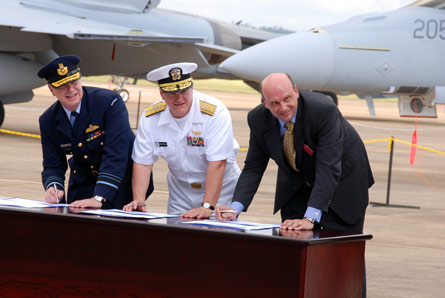The first five of 24 Boeing F/A-18F Super Hornets for the Royal Australian Air Force have arrived in Australia at its largest air force base, Amberley in Queensland. The F/A-18Fs are Canberra's first new combat aircraft in 25 years.
Australia is the first export customer for the Super Hornet, having signed an A$2.9 billion ($2.6 billion) contract in 2007. The RAAF expects Super Hornet initial operating capability by December, says Steve "Zed" Roberton, officer in commander of Super Hornet Wing.
The RAAF intends to use its Super Hornets as aircraft to fill the void between the retirement of its General Dynamics F-111 and the arrival of its Lockheed Martin F-35 Joint Strike Fighter. The F-111s will go by the end of the year and the F-35 will not arrive until 2014 at the earliest.
| |
|---|
© Will Horton/FlightglobalSuper Hornets 206, 205, 204, 203, and 202 (left to right) arrived at Amberley Air Force Base |
While the RAAF has said it will not purchase additional Super Hornets, a delay in the F-35 could be in Boeing's favour. "We're here and we provide a good risk mitigation," says Boeing vice-president, F/A-18 and EA-18 programmes Bob Gower. "At this point we're going to focus on delivering the 24 aircraft. But we'll be here if they understand us well and the capabilities they're getting."
Beyond Australia, Gower says the Super Hornet is competing in nine countries. He was most confident about the Super Hornet's potential in India, which has five other competitors for the country's Medium Multi-Role Combat Aircraft tender for 126 aircraft.
"We just completed field trials in India and I think we did very well," Gower says. He explains that Boeing showed off the Super Hornet's integration of the sensor suite and also performed a landing at 10,000ft (3,000m) above sea level. "We have the best handling qualities of any aircraft out there right now."
 |
|---|
© Will Horton/Flightglobal(left to right) RAAF Air Marshal Mark Binskin, US Navy Rear Admiral Mark Skinner and Boeing vice president, F/A-18 & EA-18 Programs, Bob Gower sign the ceremonial arrival certificates |
Gower is least confident about selling the Super Hornet to Brazil. "That's a challenge for us because they're trying to base it on a strategic relationship," he says.
Brazil's decision, expected in the short term, could hinge on "whether we could overcome technical transfer concerns," Gower says. "We've gotten unprecedented technical transfer from the US government, but there is still a little bit of mistrust between the Brazil and US governments."
Denmark recently announced it would delay by two years a decision on a Super Hornet acquisition. Gower says the delay is a result of the global financial crisis, but that Boeing is ready for potential orders. "We have a pretty good production run in front of us. We'll be there for the customer once they decide."
Meanwhile, Roberton has detailed the delivery schedule for the RAAF's remaining 19 Super Hornets. Seven are due to arrive in two formations in July.
The remaining 12, which will be wired for possible upgrade to E/A-18G Growler electronic warfare capability, will be delivered in three formations of four by the end of October 2011. "We feel comfortable to achieve that," Roberton says.
He expects a decision in the next few years from Canberra about upgrading the Super Hornets to Growlers, which would cost A$300 million collectively, in addition to the A$35 million spent for re-wiring. He says it is not clear if Canberra will upgrade all 12 or only some. "It's an option for government, and if the requirements need all 12."
Source: Flight International
























